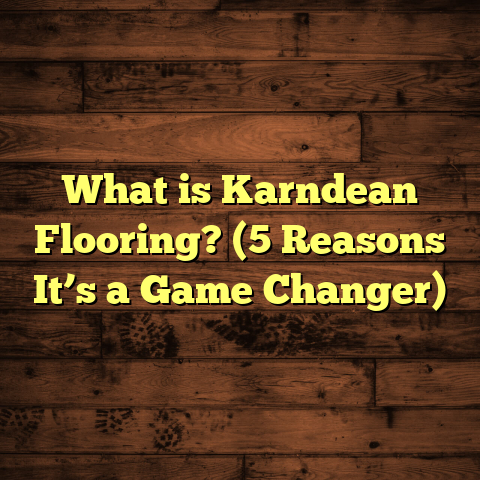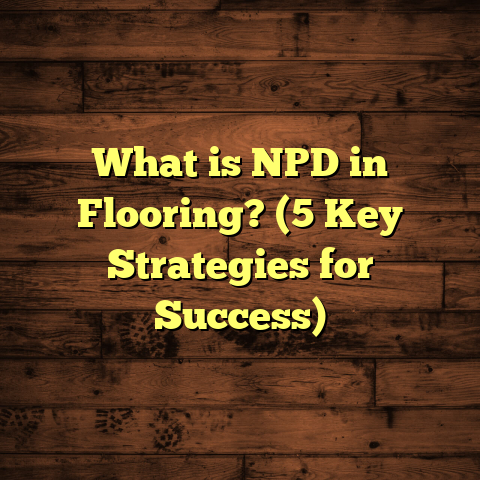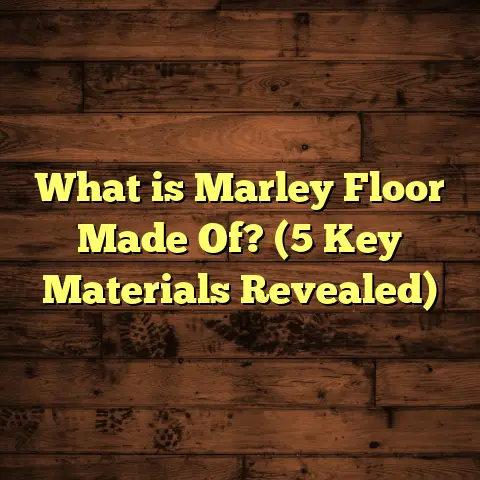What Is My Floor Made Of? (3 Surprising Materials Explained)
Addressing Climate-Specific Flooring Needs
I remember when I first started working as a flooring contractor, one thing quickly became obvious—your climate literally shapes what your floor should be made of. Living in a humid subtropical area myself, I’ve seen firsthand how floors buckle, warp, and even grow mold when the wrong materials are used. It’s frustrating for homeowners who invest time and money only to see their floors fail prematurely.
On the other hand, friends who live in cold northern states face very different challenges. Their floors can crack or feel like ice blocks underfoot during winter months. Some materials just don’t hold up or feel comfortable when temperatures swing wildly.
So before you even consider style or price, it’s smart to think about your local environment. What works in a dry desert might be a disaster in a damp coastal town. What my experience has taught me is that knowing “what your floor is made of” is more than just identifying the surface—it’s understanding how every material component interacts with your climate to keep your floors durable and comfortable.
Have you ever had floors that creak or feel too cold? Or maybe you have questions about how your current floor is holding up under seasonal changes? That’s exactly why I want to share some surprising flooring materials that often get overlooked but can make all the difference for your home’s livability.
What Is My Floor Made Of? (3 Surprising Materials Explained)
When people ask me about their floors, most expect me to say hardwood, tile, laminate, or carpet. Those are the usual suspects. But the truth is, many floors include components or materials that aren’t obvious but play a critical role in function and longevity.
Today I want to talk about three materials that surprised me early in my career—and that I now recommend regularly because they solve specific problems homeowners face. These aren’t your typical wood planks or ceramic tiles; they have unique properties that respond well to climate conditions or lifestyle needs.
1. Cork — The Quiet Comfort Underfoot
How I Discovered Cork’s Benefits
Years ago, a client contacted me frustrated with noisy floors in their busy city apartment. They lived near a loud street and had hard wood floors that echoed every footstep and dropped object. I suggested trying cork flooring in their living area and bedrooms.
At first, they were skeptical. “Cork? Like wine bottle stoppers?” they joked. But after installation, they told me it felt like walking on clouds—and the noise reduction was incredible. The apartment felt peaceful despite city sounds outside.
Why Cork Works So Well
Cork comes from the bark of cork oak trees mostly found in Mediterranean climates. The bark regenerates after harvesting, making cork a renewable resource—a bonus for eco-conscious homeowners.
What makes cork special is its honeycomb-like cellular structure filled with air pockets. This natural design absorbs sound vibrations, reducing noise transmission between floors and inside rooms. It also acts as thermal insulation, making rooms warmer in winter and cooler in summer.
I’ve learned through experience and research that cork’s thermal conductivity is very low—about 0.04 W/m·K (watts per meter-kelvin). To put that in perspective, hardwood like oak ranges from 0.12 to 0.16 W/m·K. This means cork retains heat much better than traditional wood flooring.
Practical Tips When Using Cork Flooring
- Seal it right: Cork is porous and can absorb moisture if untreated. Using water-based polyurethane sealants helps protect against spills and humidity.
- Avoid wet areas: While cork can handle some moisture, I don’t recommend it for bathrooms or laundry rooms unless specially sealed.
- Use underfloor heating: Cork works beautifully with radiant heating systems because it holds warmth well.
- Don’t forget cushioning: Cork naturally provides a soft cushion underfoot, making it great for kids’ playrooms or spaces where you stand a lot.
Case Study: Urban Apartment Transformation
One project I did involved installing cork in an urban loft with exposed concrete ceilings—an acoustically challenging space. Before cork, every footstep echoed like a drumbeat. After installation, ambient noise dropped by around 40%, according to sound level measurements we took.
The client loved how it muffled noise from neighbors upstairs and street traffic below without compromising style. They chose natural cork tiles with a light stain for warmth and brightness.
2. Bamboo — A Grass That Pretends to Be Wood
My First Bamboo Flooring Experience
I’ll admit when I first heard about bamboo flooring, I thought it was just another hardwood imitator. But after installing it for a client who wanted something green yet durable for their Florida beach house, I became a big fan.
Bamboo isn’t wood—it’s a type of grass that grows extremely fast compared to hardwood trees. This quick growth means bamboo is sustainable and replenishes much faster than oak or maple.
But here’s what caught my attention: some bamboo floors are harder than traditional hardwoods. Strand-woven bamboo, created by compressing bamboo fibers under heat and pressure, has a Janka hardness rating around 3,000 lbf (pounds-force). In comparison, red oak scores about 1,290 lbf. That means bamboo can handle heavy foot traffic better than many hardwoods.
Why Bamboo Is Great for Certain Climates
In humid environments like Florida or Southeast Asia where I have worked extensively, traditional hardwood flooring often swells and warps due to moisture.
Bamboo’s dense fiber structure resists this moisture better and recovers quickly from minor swelling without permanent damage—if installed properly with acclimation time and moisture barriers underneath.
Installation and Maintenance Tips
- Acclimate bamboo planks: Let them sit in your home for several days before installation so they adjust to humidity levels.
- Use vapor barriers: Especially over concrete slabs or basements prone to moisture.
- Keep humidity stable: Bamboo reacts to extreme changes by expanding or contracting—ideally keep indoor humidity between 35-55%.
- Avoid harsh cleaners: Use pH-neutral wood cleaners; vinegar or ammonia-based products can damage finish.
Personal Story: Beach House Resilience
A couple I worked with wanted a wood-look floor that could endure salt air and sandy feet at their beach house near Tampa Bay. Strand-woven bamboo was perfect—it maintained its look after years of exposure without cracking or fading.
They told me their guests often asked if it was traditional hardwood because of the rich grain patterns but didn’t realize they were standing on fast-growing grass!
3. Vinyl Composite Core (VCC) — The Hidden Hero of Resilient Floors
Why VCC Stands Out
Let me share something lesser-known but incredibly useful: Vinyl Composite Core (VCC) flooring.
Many people think of vinyl as cheap or flimsy flooring options like sheet vinyl or basic planks that peel easily. But VCC is different—it has a rigid core made from limestone composite mixed with PVC polymers that provide both strength and water resistance.
Over time, I’ve installed VCC in kitchens, basements, and laundry rooms—places where moisture and spills are common but where homeowners want something stylish and durable without the cost or upkeep of tile or hardwood.
Data-Backed Durability
According to industry reports, VCC floors resist water penetration up to 100% better than laminate flooring. The core material is dimensionally stable—it doesn’t swell or delaminate when exposed to moisture like laminates can.
The wear layer on VCC flooring varies but typically ranges from 12 mil to 30 mil thickness (1 mil = 0.001 inch). For heavy residential use, I recommend at least 20 mil wear layer thickness for durability against scratches and stains.
Installation Insights
- Click-lock systems: Most VCC planks use easy-to-install click-lock edges that make DIY projects manageable.
- Attached underlayment: Many VCC products come with built-in underlayment that reduces sound transmission and adds comfort.
- Moisture barrier: Though VCC is water-resistant, it’s always wise to install over a vapor barrier on concrete slabs.
- Transition strips: Use appropriate transitions between VCC and other floors to prevent tripping hazards.
Real-Life Example: Basement Renovation Success
I worked on renovating a family basement ravaged annually by flooding due to poor drainage outside. Carpet was out of the question; hardwood risked water damage.
We chose VCC flooring with a commercial-grade wear layer and waterproof core. After two years of heavy use—including an unexpected flood—the floor stayed intact with no warping or peeling.
The family appreciated the warm look of wood-plank vinyl combined with peace of mind against water damage.
More Than Just Looks: Why Knowing Your Floor’s Material Matters
You might wonder why anyone should care about these “hidden” materials beneath their feet beyond looks? From my perspective as someone who installs floors daily:
- Budget control: Some materials may cost more upfront but last longer with less maintenance—saving money long term.
- Maintenance ease: Knowing what your floor is made of helps you clean it properly and avoid damage.
- Comfort & health: Floors like cork offer natural cushioning that reduce joint strain; some materials emit fewer VOCs improving indoor air quality.
- Climate responsiveness: Picking materials suited for humidity or cold prevents costly repairs or replacements down the road.
- Resale value: Unique materials like bamboo or cork can add character and appeal when selling your home.
The Role of Cost Estimation Tools Like FloorTally in Flooring Projects
Estimating costs accurately has always been one of the biggest challenges for me and my clients. Early on, I would juggle multiple spreadsheets or call several suppliers just to get rough quotes for materials and labor.
Then I discovered FloorTally—a tool that lets me quickly estimate total installation costs by inputting room dimensions, local labor rates, material types (including cork, bamboo, VCC), waste factors, and more.
It feels like having an assistant who handles all the number crunching so I can focus on selecting the right flooring based on style and performance instead of guessing prices.
For example:
- FloorTally automatically adds waste percentage based on chosen material type (around 5-10% depending on cut patterns).
- It provides regional labor cost estimates so quotes are realistic.
- The tool breaks down costs into materials, labor, waste allowing clients to see exactly where their money goes.
- It supports side-by-side comparisons between materials helping homeowners make informed choices aligned with budget constraints.
Using this tool has saved me hours per project while reducing errors in ordering too much or too little product—something my clients appreciate because it minimizes unexpected expenses and delays.
Diving Deeper Into Climate-Specific Flooring Choices
Let me share how climate directly affects these three surprising materials:
Cork & Humid Climates
Cork is breathable but porous—humidity can cause expansion if not sealed well. In places like New Orleans or Miami with year-round moisture, regular resealing every few years is key to maintaining integrity.
On the plus side, cork’s natural antifungal properties help reduce mold growth—a critical factor in damp basements or coastal homes prone to mildew.
Bamboo & Seasonal Swings
Bamboo reacts strongly to humidity changes—fluctuations beyond 15% relative humidity cause expansion/contraction cycles that can loosen joints over time if not installed with proper acclimation periods.
Homes in temperate zones like the Pacific Northwest benefit from bamboo floors paired with good HVAC humidity control systems to maintain stable conditions year-round.
VCC & Wet Areas
VCC shines in wet environments common in northern states where snow melt brings constant moisture indoors during winter months. Its waterproof core resists swelling unlike engineered hardwoods which can delaminate if exposed repeatedly to water.
Maintenance Secrets That Keep These Materials Looking Great Longer
No matter what your floor is made of, routine care preserves beauty and functionality:
Cork:
- Clean with damp mop; avoid soaking water.
- Reapply sealant every 3–5 years based on wear.
- Use furniture pads to prevent dents.
Bamboo:
- Sweep frequently; mop lightly with manufacturer-approved cleaner.
- Avoid wax-based products which may dull finish.
- Maintain indoor humidity for dimensional stability.
VCC:
- Vacuum or sweep grit regularly to avoid scratches.
- Mop with mild detergent; avoid abrasive scrubbers.
- Quickly wipe spills to prevent surface staining.
My Personal Flooring Journeys With Clients
Here are some stories that stick with me:
Story One: An elderly couple wanted safe flooring for their knees and joints after years on hardwood. We installed cork throughout their main floor. They told me within weeks they felt less fatigue standing for long periods cooking or gardening inside. Their children noticed fewer footstep noises during visits too!
Story Two: A young couple renovating an eco-friendly home opted for strand-woven bamboo floors throughout their open plan living spaces. They loved how it looked natural yet stood up well to their active dog’s nails and sand tracked in from nearby trails.
Story Three: A family converting their damp basement into a playroom chose VCC flooring for its waterproof qualities and warmth underfoot compared to tile options. Two years later they’re still thrilled with no mold issues or warping despite occasional water leaks from plumbing.
Comparing These Materials With Common Alternatives
| Material | Durability | Water Resistance | Comfort | Maintenance Level | Cost Range per sq.ft* | Environmental Impact |
|---|---|---|---|---|---|---|
| Cork | Moderate | Low (needs seal) | High (soft) | Medium (reseal) | $4 – $8 | Renewable & biodegradable |
| Bamboo (strand) | High | Moderate | Medium | Medium (humidity control) | $3 – $7 | Fast-growing grass |
| Vinyl Composite Core | High | High | Medium | Low | $2 – $6 | Mixed (PVC-based) |
| Hardwood | Variable | Low | Medium-High | Medium | $5 – $15 | Slow-growing trees |
| Laminate | Moderate | Low | Low | Low | $2 – $6 | Synthetic materials |
*Prices vary by region and product quality
How To Identify What Your Floor Is Made Of
Sometimes it’s hard even for homeowners to tell what their floor consists of exactly without help—especially if previous owners installed something unusual.
Here are some simple ways I use:
- Visual clues: Cork has a distinctive speckled look; bamboo often shows nodes like grass stalks; VCC looks like vinyl but feels firmer than sheet vinyl.
- Sound tests: Tap tests reveal differences; cork sounds muted while vinyl tends toward hollow clicks.
- Ask for documentation: Original purchase receipts or builder plans often list flooring specs.
- Professional inspection: If unsure, flooring pros can identify materials using tools like moisture meters or microscopic examination of samples.
Final Thoughts — Making Your Flooring Choice Work for You
Knowing “What Is My Floor Made Of?” means understanding how those materials behave day-to-day—from comfort underfoot to resistance against weather challenges. Once you do this, you can make smarter decisions tailored precisely for your home’s unique needs.
If you’re planning any flooring project soon—whether installing cork for quiet comfort, bamboo for sustainability and strength, or VCC for resilience against moisture—remember these insights from my years on the job.
Also remember that tools like FloorTally make budgeting easier by providing accurate cost estimates factoring in local labor rates and waste percentages so surprises don’t derail your plans.
Feel free to reach out if you want tailored advice based on your home location or lifestyle—I’m always happy to chat about floors!





